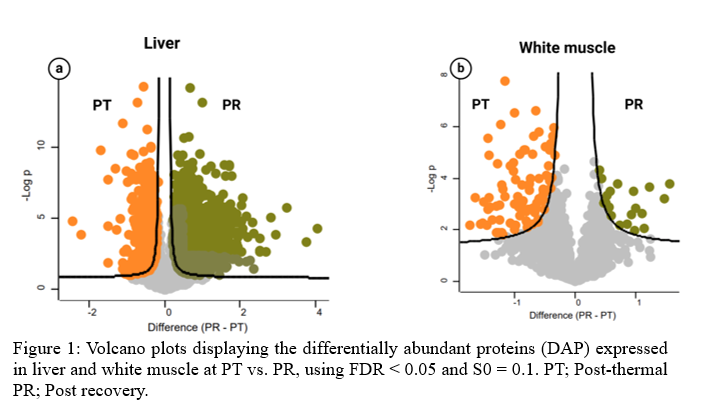BENCHMARKING ATLANTIC SALMON Salmo salar PERFORMANCE TO TEST TRANSLATION OF RESEARCH FROM EXPERIMENTAL TO COMMERCIAL SYSTEMS USING PROTEOMICS
Introduction
Temperature regulates all aspects of growth and physio-metabolic processes in Atlantic salmon . In Tasmania, t he production of Atlantic salmon is highly exposed to the effects of climate change due to the increasing prevalence of marine heatwaves. However, further research on the accuracy of experiments in controlled conditions in predicting farmed fish response to natural conditions is highly recommended. In this study, the cumulative effects of suboptimum environmental conditions on large salmon production biology were investigated using proteomics, and by comparing two genetically equivalent populations with similar size : one grown in an experimental recirculating aquaculture system (RAS) and the other in a commercial pen.
Materials and Methods
In the RAS, n = 631 large salmon (mean weight ~2.5 kg) were exposed to a simulated summer of 19°C and 80% DO for 84 days, followed by 40 days of autumn recovery at 15°C and 100% DO, referred to as post-thermal and post-recovery time points, respectively . The liver and white muscle tissue samples were collected from targeted individuals (from known genotypic groups of the Tasmanian Selective Breeding Program) expected to show high, medium and low growth performance (n = 8 samples per group per time point; n = 24 per tissue per time point) . In addition, this study collected same type and number of tissues (n = 24) from genetically equivalent individuals from a commercial pen at the end of a natural summer (~16.75°C; 78.92 % DO) to compare the proteomic response with the RAS simulated summer.
Results
In the RAS, p roteomic analysis of the liver and white muscle identified ~6900 and ~1900 protein groups, respectively. Statistical analysis (FDR < 0.05) of the liver and white muscle proteomics data identified 2614 and 119 differentially abundant proteins (DAPs), respectively, between the two timepoints (Figure 1). When comparing simulated with natural summer, 3983 and 357 DAPs distinguished RAS from the pen . In the RAS, gene ontology analysis of the liver identified terms related to protein folding, SERPINh-1, and lactate metabolism among the proteins increased in the post-thermal group, and lysosomes, ribosome biogenesis, and unsaturated fatty acid biosynthesis in post-recovery. In white muscle, glucose and pyruvate metabolism, were enriched in both timepoints , with protein folding enriched only at post-thermal . In the pen, gene ontology analysis revealed shared cardinal markers (SERPINh-1), and mechanisms (endoplasmic processing, protein turnover) related to thermal stress with the RAS, while immunomodulatory proteins of innate and humoral responses were enriched only in the pen, capturing the different nature of commercial environment.
Conclusion
Overall, the results showed increased energy reallocation during suboptimum environmental stress and prolonged physiological recovery in large Atlantic salmon . Additionally, the findings support the use of an experimental RAS as a potential translational tool for commercial applications.
